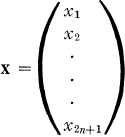Crossref Citations
This article has been cited by the following publications. This list is generated based on data provided by
Crossref.
Kestenband, Barbu C.
1982.
Finite projective geometries that are incidence structures of caps.
Linear Algebra and its Applications,
Vol. 48,
Issue. ,
p.
303.
Kestenband, Barbu C.
1983.
Partitions of finite affine geometries into caps.
Linear and Multilinear Algebra,
Vol. 14,
Issue. 3,
p.
257.
Kestenband, Barbu C.
1988.
Partitioning projective planes into arcs.
Mathematical Proceedings of the Cambridge Philosophical Society,
Vol. 104,
Issue. 3,
p.
435.
Bruen, A.A.
and
Hirschfeld, J.W.P.
1988.
Intersections in Projective Space II: Pencils of Quadrics.
European Journal of Combinatorics,
Vol. 9,
Issue. 3,
p.
255.
Kestenband, Barbu C.
1989.
Partitions of Desarguesian and Hughes planes into complete and incomplete arcs.
Journal of Geometry,
Vol. 36,
Issue. 1-2,
p.
91.
Ueberberg, Johannes
1997.
Projective planes and dihedral groups.
Discrete Mathematics,
Vol. 174,
Issue. 1-3,
p.
337.
Rinaldi, G.
2001.
Complete unital-derived arcs in the hall planes.
Abhandlungen aus dem Mathematischen Seminar der Universität Hamburg,
Vol. 71,
Issue. 1,
p.
197.
Giulietti, Massimo
2008.
On cyclic caps in 4-dimensional projective spaces.
Designs, Codes and Cryptography,
Vol. 47,
Issue. 1-3,
p.
135.
Edoukou, F. A. B.
Hallez, A.
Rodier, F.
and
Storme, L.
2010.
The small weight codewords of the functional codes associated to non-singular Hermitian varieties.
Designs, Codes and Cryptography,
Vol. 56,
Issue. 2-3,
p.
219.
Follett, Michael
Kalail, Kyle
McMahon, Elizabeth
Pelland, Catherine
and
Won, Robert
2014.
Partitions ofAG(4,3)into maximal caps.
Discrete Mathematics,
Vol. 337,
Issue. ,
p.
1.
Pavese, Francesco
2015.
On Singer action on Hermitian varieties.
Journal of Geometry,
Vol. 106,
Issue. 1,
p.
19.
Cossidente, Antonio
2017.
Surveys in Combinatorics 2017.
p.
204.
Cossidente, Antonio
and
Pavese, Francesco
2018.
On intriguing sets of finite symplectic spaces.
Designs, Codes and Cryptography,
Vol. 86,
Issue. 5,
p.
1161.





